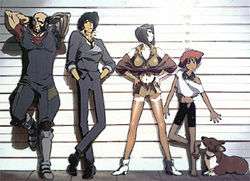Shinichirō Watanabe
| Shinichirō Watanabe | |
|---|---|
 Watanabe at the 2009 Japan Expo | |
| Native name | 渡辺 信一郎 |
| Born |
May 24, 1965 Kyoto, Japan |
| Occupation | Film director, screenwriter, animator, producer, actor |
| Years active | 1990–present |
| Part of a series on |
| Anime and manga |
|---|
 |
|
Selected biographies |
|
|
|
General |
|
|
Shinichirō Watanabe (渡辺 信一郎 Watanabe Shin'ichirō, born May 24, 1965 in Kyoto) is a Japanese anime filmmaker, screenwriter, and producer. He is best known for directing the critically acclaimed and commercially successful anime series Cowboy Bebop and Samurai Champloo.
Watanabe is known for incorporating multiple genres into his anime creations. In Cowboy Bebop, for example, Watanabe blends classic cowboy western with 1960s/1970s New York City film noir, jazz/blues music, Hong Kong action movies, and sets the entire series in space. In his later work, Samurai Champloo, Watanabe unites the cultures of Okinawa, hip hop, modern-day Japan, and chanbara.
Career

Born in Kyoto, Watanabe, after joining the Japanese animation studio Sunrise, supervised the episode direction and storyboards of numerous Sunrise anime, and soon made his directorial debut as co-director of the well-received Macross update, Macross Plus. His next effort, and first full directorial venture, was the 1998 series Cowboy Bebop, which received universal praise and is considered by many to be one of the greatest anime series of all time. It was followed by the 2001 film Knockin' on Heaven's Door. In 2003, Watanabe directed his first American-produced anime, the short films Kid's Story and A Detective Story, both part of The Wachowskis' The Animatrix, an anthology of animated short stories from The Matrix. His next directorial effort was the critically acclaimed 2004 anime series Samurai Champloo which began broadcasting on Fuji Television in Japan on May 19, 2004.
Following the release of Samurai Champloo, Watanabe directed a short film called Baby Blue which was released on July 7, 2007 as a segment of the anthology film Genius Party.[1] In recent years, he has been active as a creative music producer, overseeing the 2004 film Mind Game, 2008's Michiko & Hatchin, and supervising the storyboards for episode 12 of Tetsuwan Birdy: Decode. In 2012, he directed the anime series Kids on the Slope (Japanese title: Sakamichi no Apollon), a coming-of-age story about young jazz musicians, which premiered in April 2012 on Fuji TV's Noitamina block.[2]
In 2009 it was announced that Watanabe would be working as an associate producer on the upcoming live-action adaptation of Cowboy Bebop, alongside his fellow Sunrise staff members Kenji Uchida and Keiko Nobumoto.[3] As of 2014, the project is in hiatus. During FicZone in Granada, Spain, it was reported that Watanabe was collaborating with anime studio BONES on a space science-fiction comedy. BONES subsequently confirmed that the studio was working with Watanabe, but did not confirm the genre of the series.[4] In late 2013, the original trailers for Space Dandy were released to the public. The dubbed version premiered on Toonami on January 4, 2014 in the United States, before airing in Japan. He is frequently ranked among Japan's best animation directors.[5]
Notable works
Television productions
As director:
- Cowboy Bebop (1998)
- Samurai Champloo (2004)
- Kids on the Slope (2012)
- Space Dandy (2014, chief director)
- Terror in Resonance (2014)
Other:
- Obatarian (1990; episode supervision)
- Genki Bakuhatsu Ganbaruger (1992; episode supervision)
- The Vision of Escaflowne (1996; unit director episode 5 & 8, storyboards episode 5, 8, 12 & 16)
- Eureka Seven (2005; supervision of third ending theme)
- Tetsuwan Birdy DECODE (2008; storyboard supervision, episode 12)
- Michiko to Hatchin (2008; music producer)
- Star Driver: Kagayaki no Takuto (2010; storyboard & unit director, OP 1)
- Lupin the Third: The Woman Called Fujiko Mine (2012; music producer)
OVA
- Armor Hunter Mellowlink (1988–1989; episode supervision)
- Capricorn (1991; co-supervision of storyboard)
- Mobile Suit Gundam 0083: Stardust Memory (1991; episode supervision)
- Macross Plus (1994; co-director)
- The Animatrix (2003; episode direction)
Films
- Macross Plus: Movie Edition (1995; co-director)
- Cowboy Bebop: Knockin' on Heaven's Door (2001; director)
- Mind Game (2004; music producer)
- Genius Party (omnibus): Baby Blue (2008; director)
- Cowboy Bebop (development in hiatus[?]; associate producer)
Use of music
Watanabe has a distinct vision regarding the importance of the film score of his works and believes that music is the universal language. Cowboy Bebop is heavily influenced by American culture, especially the jazz movements of the 1940s, hence the title "bebop". This style is blended with a score by the prolific composer Yoko Kanno featuring jazz, blues and funk music. The anachronistic soundtrack of Samurai Champloo, though an Edo period piece, draws heavily from hip hop music, while the later series Kids on the Slope demonstrates many classical forms of jazz. His latest series, Space Dandy, draws from primarily disco and electronic influences.
References
- ↑ Shinichiro Watanabe at Detroit Film Theatre, Feb. 8th, 2006
- ↑ "Apollon Reunites Cowboy Bebop Director, Composer Kanno". Anime News Network. 2012-01-26.
- ↑ 『カウボーイビバップ』映画実写化へ向けて始動! (in Japanese). Sunrise. 2009-01-15. Retrieved 2009-01-18.
- ↑ "Cowboy Bebop Helmer Shinichiro Watanabe, BONES Plan New TV Anime". Anime News Network. 16 October 2012. Retrieved 16 October 2012.
- ↑
External links
- Shinichirô Watanabe at the Internet Movie Database
- Shinichirō Watanabe at Anime News Network's encyclopedia